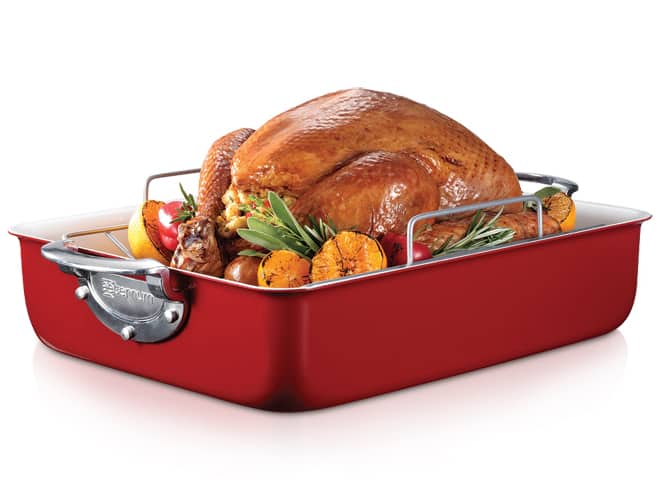Cooking tender, succulent roasts and poultry, tasty veggies and bubbling batches of lasagna requires the right roasting pan. With the many pans on the market, it pays to take the time to choose a high quality roaster.
Before investing in a roasting pan for your kitchen, be sure to consider these five key criteria of choosing a top-notch pan.
1. Construction
Thick, well-made roasting pans distribute heat well, which means even cooking and superior browning. Choose a pan with some heft. Thin pans lead to spotty browning and burning. They also warp and buckle, which is especially problematic when you’re attempting to deglaze the pan to make sauce or you’re trying to sear the meat before putting it in the oven.
2. Materials
Roasting pans come in a variety of materials, including stainless steel, which is a particularly good choice, as it is strong and doesn’t warp. It’s also an attractive piece of cookware that can be brought to the table. Aluminum is another common roasting pan material, but it reacts with acidic ingredients and can warp. It is, however, a better conductor of heat than stainless steel.
Nonstick roasting pans are available and make for easy cleanup, they don’t work well for deglazing and creating sauces, which rely on browned-on pan drippings for their rich flavors. The nonstick finish can also be rubbed off by the roasting rack.
3. Size and depth
The size and depth of the roasting pan also affect its performance. Choose a pan that is roomy enough for large pieces of meat and poultry, which shouldn’t touch the sides of the pan, but make sure that it will fit comfortably in your oven and that it isn’t so large that the meat juices burn.
In terms of depth, keep in mind that while shallow pans tend to cook foods more quickly, they don’t lead to as much browning as deeper ones and can cause vegetables to dry out rather than cook in their own juices. When you are braising or making sauce on the stove in a shallow pan, the juices also tend to easily slosh over the sides.
4. Handles
For safety and easy handling, look for a roasting pan with upright, riveted handles that are fixed, not movable The handles should be easy to grasp when wearing oven mitts, but not so large that they get in the way when you put the pan in the oven or from fitting in your dishwasher.
5. A Rack
A rack suspends the piece of meat you’re roasting so that the heat makes contact with the underside, creating a crispy coating on the bottom. Suspending the roast or poultry also allows the juices to drip rather than get absorbed back into the meat.
Look for a durable rack that will not bow when you set a large piece of meat on it. And choose one that has handles that are opposite to those of the roasting pan, so that you can easily differentiate between the two.
Now that you know what makes a high-quality roasting pan, you have all the information you need to choose the best roaster for your kitchen.
Julie Bawden-Davis

